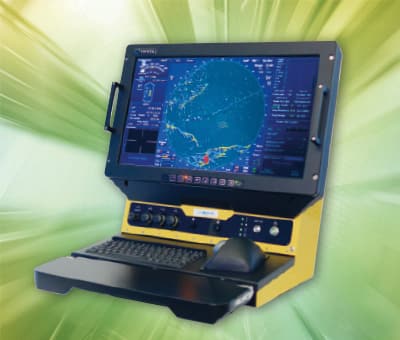The purpose of this editorial is to shed some light on what is hidden under the terms "multi function naval console" or "multifunction land console".
We are talking here about products for mainly military, defence and security applications that we will find on board surface ships, frigates, maritime patrol vessels, submarines, ... but not only for the navy but also on land in shelters, control stations, command posts, ...
Consoles "in the Air" have different requirements, especially in terms of environmental qualifications.
If you're interested by and request it, these systems for e.g. in maritime patrol aircraft will be the subject of a future article.
The multi function consoles will allow an operator to visualize in real time data coming from multiple sensors, sonars, radars, various on-board or high speed long range external devices, ... to analyse and process information in a short period time for surveillance or Sar missions, for identification friend foe (IFF), to control systems as weapon systems, to cross data and to interact with the combat management system (CMS), for communications for e.g. with assault craft, ... but also for some other purposes as fire control, management system integrated for access and utilities, …
This is what a multifunctional console for ground or naval missions looks like, allowing it to perform a wide range of missions at sea or on land.
What are the points to consider when choosing a naval or land multi function console?
- Your application is for Navy, land? Where will the console be integrated? What are the requirements?
- Is the console going to be installed on board on a bench, on a pedestal?
- Which size screen, resolution required (4/3, high, 4K, …), need for a touch screen, what type?
- How many screens on the console, 1, 2 or even 3 screens?
- How are the screens positioned, one under the other, one next to the other?
- What pre-qualifications are required, MIL STD-810/167-1, STANAG 4435/ 1008, ... other qualifications?
- Ergonomics: Did a domain expert cooperated in the design? (operator position, seat height, other parameters for a comfortable and efficient work, …)
- Modularity, Scalability, Maintenance & End of Life Management: Is the system based on building blocks, rugged COTS?
- Customization***: Colour, Logo, Input/pointing devices, Front panel, Back panel, MIL STD & other connectors transfers, "Inside" computer configuration, ... can they be easily adapted to fit the needs?
- Additional options or functions: Availability of HUMS (Health and Usage Monitoring System for the control of temperatures, voltages, shocks, vibrations, hygrometry, fans, ...), Ethernet switch, ...?
- Support & services: Experience and capacity of your supplier to "surround" the product, to support you from pre-sales to after-sales technical support, MCO, ...?
- Ease of maintenance, what LRU & MTTR?
- Weight & Size?
- Availability of a range of standard products for different needs such as new equipment or retrofit operation?
- Cost of ownership?
***: U.s. navy, U.s. Air force, German navy, … or mod of countries as France, Spain, Portugal, South Africa, Japan, Korea, … or missions in Atlantic & Pacific oceans, Mediterranean Sea, … all these needs will have common basis functions but all will each time require customisations.
A short video will tell you more than a long speech, take 2mn:41s for the presentation of a multifunction naval console.
These products deployed on board or in the field can also be used in testing platforms or integration platforms for e.g. combat management system simulation with the all the devices connected.
In order to optimize costs, some suppliers offer versions with much lighter boxes & peripherals while keeping the same basic electronics.
It should also be noted that lighter variants, usable in less hostile environments, sometimes mobile, at lower costs, ... are beginning to appear for applications such as control, piloting of drones, tactical missions, Hmi for derivative missions.
Often the needs are specific to the project and are the subject of MOTS or developments on customer specifications.
And to finish on a humorous note, a console on board sometimes plays the role of a footboard, ... and must therefore be very robust to support a very sturdy operator ...
As … said, experience is not just an old lantern used to light the way already made ...

